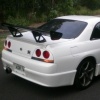R33 Rb30 Conversion
Announcements
-
Similar Content
-
Latest Posts
-
Well, the trouble with that ^^ is: The configuration shown is absolutely a 1-way, not a 1.5-way. There is no way that a 1.5-way can be said to offer LSD action only on acceleration. If Nismo cannot get that right, then it is impossible to believe their documentation. That ^ is not a 1.5 way setup. That is a 1-way. And so now I have allowed all doubts to flourish and have gone back to look at the MotoIQ video. I originally made the mistake of believing him when he said "this is a 1.5-way" at the ~6:10 mark. Because what he did was take the gear assembly out of the 2-way opening and just rotate it one place to the left to drop it into the 1-way opening. When he dropped it in there, the cam was "backwards" compared to the correct orientation shown in all other photos of that config. The flat shold have been facing the 1° ramp side of the opening, not the 55° ramp side. And I thought, "gee that's cute", but I was concerned at the time, when he put the other ring back on, that the gap between the rings looked like it was wider then in the 2-way config. And then I said a lot of things in my long post on Tuesday that could only make sense if the guy from MotoIQ was correct about what he'd done. BUT... I have now done my homework. I grabbed a frame of the video with the 2-way config, and then grabbed another with the "1.5-way" config, snipped out the cam and opening of that frame and just pasted it direct on top of the 2-way config. I scaled it so that the triangular opening was almost exactly the same height in both. AND.... the gap between the plates is wider with the cam installed in the triangualr opening backwards. That is.... it cannot go together that way. There would be massive force on the plates all the time, if you could even reassemble it. So, My statement on the matter? The Nismo diff is actually only a 2-way and 1-way. There is no 1.5-way option in it, regardless of what they say. Here's a photo of a real 1.5-way ramp opening from Cusco (along with the 1 way option). And the full set of 1 through 2 way options from their racing diff, which is not same-same as what we'd typically be using, but...the cams work the same. A little blurry, but it comes from this Cusco doc, which is quite helpful. AND.... Cusco do in fact do what I suggested would be sensible, which is to have rings that do 1 and 1.5, and 1.5 and 2. Separately.
-
"With a 1.5-WAY, the LSD is effective only during acceleration."
-
By TurboTapin · Posted
Well it wasn't as easy as I thought.... and it also wasn't in my original manual which I did end up finding. They discuss the process in the Nismo catalogue though and it requires slight machining. Page 145. NISMO PARTS CATALOGUE 2020 -
By TurboTapin · Posted
I'm an idiot, my intercooler is rated for 1000hp. I had clicked on the wrong product. Knowing the delta P would be nice, but I'm doubtful I'll do it. Now as for an EMAP, that would be great and I'll get around to it eventually but from my findings in my last post, I'm considering a turbo swap now.
-







Recommended Posts
Create an account or sign in to comment
You need to be a member in order to leave a comment
Create an account
Sign up for a new account in our community. It's easy!
Register a new accountSign in
Already have an account? Sign in here.
Sign In Now